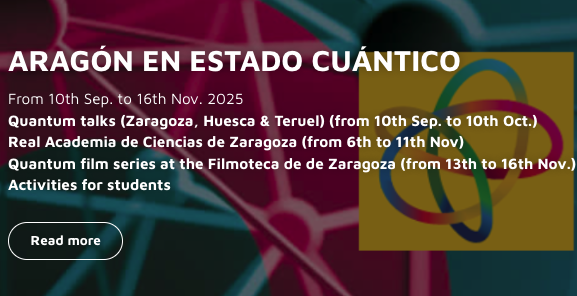Aragon experiences a quantum autumn
The Aragon Nanoscience and Materials Institute (INMA), a joint institute of the Spanish National Research Council (CSIC) and the University of Zaragoza, is launching a programme of exhibitions, talks and a film series at the Film Library to bring quantum physics closer to the people of Aragon.
The events kick off with the opening of an exhibition at the Centro de Historias and the first “quantum” talk by the deputy director of INMA and CSIC research professor, Luis Martín Moreno
Zaragoza, 5 September. This autumn, Aragón will be one of the main epicentres of quantum dissemination in Spain. To mark the International Year of Quantum Science and Technology, the Institute of Nanoscience and Materials of Aragon (INMA), a joint institute of the CSIC and the University of Zaragoza, has designed an extensive programme of activities open to the public that will combine science, technology, culture and education in different venues in Zaragoza, Huesca and Teruel.
Talks, exhibitions, films, interactive experiences and lectures by national experts will come together in this initiative entitled ‘Aragón en Estado Cuántico’ (Aragon in a Quantum State), which aims to bring quantum physics closer to the public and highlight the role played by science developed in Aragon in one of the most promising fields of current knowledge.
The events begin on Wednesday, 10 September, with the opening of an exhibition at the Centro de Historias in Zaragoza, which will subsequently travel around the three provinces. The exhibition will open at 6 p.m. and will be followed by the first “quantum talk” in the series, in which researcher Luis Martín Moreno will speak on: ‘Quantum Physics: Why is nature so strange?’
During September, October and November, the exhibition will travel to the Villahermosa Palace in Huesca, the CEFCA in Teruel and the CSIC delegation in Aragon. In addition, thanks to the collaboration of the Royal Academy of Exact, Physical, Chemical and Natural Sciences of Zaragoza, visitors will also be able to see the exhibition by Miguel Catalán, an Aragonese pioneer in this field, in the Paraninfo of the University of Zaragoza, together with lectures scheduled for 11th November.
Furthermore, until November, visitors will be able to enjoy a series of “quantum cinema” at the Zaragoza Film Library, and there will be round tables and informative talks by leading researchers, many of them linked to INMA itself, a Severo Ochoa centre of excellence.
The second quantum revolution is already here
Quantum physics is one of the most successful scientific theories of all time. Although its language (made up of probabilities, superpositions and entangled particles) can be difficult to understand, it is already part of our everyday lives through such common tools as the GPS we use to get around the city; the chips and transistors in our mobile phones and computers; and MRI scans in hospitals. We are now experiencing the so-called second quantum revolution, which will bring even more groundbreaking applications such as ultra-precise sensors and quantum computing.
The ‘Aragón en Estado Cuántico’ (Aragon in a Quantum State) project is part of the celebration of the centenary of the foundational works of quantum physics, signed by figures such as Albert Einstein and Werner Heisenberg, which marked the beginning of a true revolution in our understanding of the world.
It is hoped that this programme will not only serve to raise awareness of the importance of quantum physics, but also to encourage scientific vocations, build bridges between research and society, and highlight the role of Aragon as a region with talent and the capacity to compete at the frontier of knowledge.
INMA, Severo Ochoa Centre of Excellence
In 2024, the Aragón Institute of Nanoscience and Materials (INMA) became the first research centre in the region to receive Severo Ochoa Centre of Excellence accreditation. This recognition entails funding of €4,500,000 and the awarding of five pre-doctoral contracts for the period 2024–2028, in addition to the ten that were awarded in the previous call for applications.
INMA has an integrative approach that translates research into nanomaterials into solutions for societal challenges. The institute currently has around 300 members and more than 40 European projects underway. It has an annual average of 300 publications and €7 million obtained in competitive public programmes.
In addition to having created numerous technology-based companies, four of which are active, it has 15 valid patents, five of which are licensed. INMA works closely with industry. All this provides around one million euros in annual revenue.
For more information and interviews: 699 49 80 89
For more information about the talks: Llega “Aragón en Estado Cuántico”
05-09-2025









